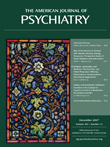Hyperammonemia and Valproic Acid-Induced Encephalopathy
To The Editor: We read with great interest the thought-provoking clinical case conference by Russell B. Carr, M.D., and Kerrie Shrewsbury, M.D., in the July 2007 issue of the Journal describing the difficulty in predicting hyperammonemia-induced encephalopathy. The authors stated that “hyperammonemia occurs at both therapeutic and supratherapeutic concentrations of valproic acid, implying that other factors often influence the development of symptomatic hyperammonemia” ( 1 , p. 1022). We propose that increased free valproic acid levels in the presence of normal total levels might be an unidentified factor that may mediate hyperammonemia as well as valproic acid-induced encephalopathy.
The importance of monitoring free valproic acid levels has been described in several single-case and case-series reports and deserves more systematic research. A high free valproic acid level with a normal total valproic acid level has been described when both valproic acid and aspirin were taken (2) . The relationship between free and total valproic acid was shown to be linear when the total valproic acid level was in the lower therapeutic range (r=0.68) (3) . However, free fraction of valproic acid increases nonlinearly at higher total valproic acid levels. Similarly, Henriksen et al. (4) found nonlinear increases of free valproic acid above the recommended therapeutic total valproic acid range when protein binding sites were saturated. Using available data from Buchanan and Ponniah (5) , Figure 1 demonstrates an exponential increase in free valproic acid with increased concentration of total valproic acid (7.4×e 0.0035 , R 2 =0.93). This exponential relationship shows a stronger fit than the linear relationship noted by Roman et al. (3) (r=0.68 vs. R 2 =0.93).

a Data from Buchanan N and Ponniah P (5).
Upon valproic acid binding site saturation on albumin, subsequent incremental changes in total valproic acid may cause disproportional increases in free valproic acid. This may play a significant role in adverse effects, particularly when other drugs that might inhibit valproic acid metabolism are also administered (2) . We agree with Drs. Carr and Shrewsbury that polypharmacy and malnutrition are among the most likely risk factors for hyperammonemia. Under these circumstances, pharmacologically significant drug-drug interactions should be a cause of considerable concern. To better understand the relationship between valproic acid and hyperammonemia, it appears prudent to monitor free valproic acid levels, especially in the setting of polypharmacy and hypoalbuminemia.
1. Carr RB, Shrewsbury K: Hyperammonemia due to valproic acid in the psychiatric setting. Am J Psychiatry 2007; 164:1020–1027Google Scholar
2. Sandson NB, Marcucci C, Bourke DL, Smith-Lamacchia R: An interaction between aspirin and valproate: the relevance of plasma protein displacement drug-drug interactions. Am J Psychiatry 2006; 163:1891–1896Google Scholar
3. Roman EJ, Ponniah P, Lambert JB, Buchanan N: Free sodium valproate monitoring. Br J Clin Pharmacol 1982; 13:452–455Google Scholar
4. Henriksen O, Johannessen SI: Clinical and pharmacokinetic observations on sodium valproate—a 5-year follow-up study in 100 children with epilepsy. Acta Neurol Scand 1982; 65:504–523Google Scholar
5. Buchanan N, Ponniah P: Value of measuring salivary and free serum sodium valproate concentrations. Med J Aust 1981; 1:539–540Google Scholar



